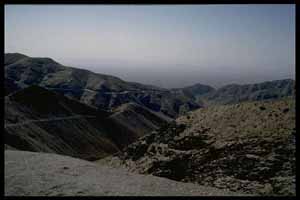|
|
 |
South Waziristan = The land of Mehsuds & Wazirs
|
|
 |
In 1878 an irregular Corps had been raised from local tribesmen i.e. Afridi in Khyber to protect traffic moving through the Khyber Pass, picquetting the hills on either side, protecting the route between the Afghan Frontier and Jamrud at the Eastern end of the pass. The Khyber Rifles (old Khyber Jezailchis) through practical experience, were reckoned on all accounts, to be a success, and if Afridis could be made into a useful local militia, surely this could be done elsewhere too.
To the Britishers the core of the Frontier problem was Waziristan and in particular its two largest tribes the Mahsuds of South Waziristan and Wazirs of the North Waziristan. The Political Agent of North Waziristan from his Headquarters in Bannu and the Political Agent of South Waziristan from the Headquarters in Tank, employed local levies who were quite useless but retained on the pay with the hope that they could thereby be kept out of mischief.
Wazirs and Mahsuds are related but were seldom on good terms. Both tribes were very difficult to handle. It was against this background that the North Waziristan Militia and South Waziristan Militia were formed in 1900. Each Corps consisted initially of 850 men, soon increased to 1850, half trans-Frontier, half cis-Frontier divided into two wings of approximately battalion strength each, and 150 mounted infantry (MI). They were armed with Martini rifles. Each Corps had six British Officers, two in each wing, the Commandant and the Adjutant/Quartermaster who also commanded the MI.
The South Waziristan Militia with Headquarters at Wana had to protect two routes from Murtaza to Wana. The nearest military garrison was in Jandola. First Commandant of the South Waziristan Militia was Lt. Col. R.H. Harman D.S.O who took over as the Commandant on first 1st July 1900 and continued commanding it till he was stabbed to death by a Shabi Khel Mahsud Sepoy Shabir Khan in January 1905.
For quite some time South Waziristan Militia kept supporting the regular army in its operations in the Agency from its Headquarters at Khargai. In March 1923 their Headquarters were shifted to Jandola.
In 1921 South Waziristan Militia was replaced by South Waziristan Scouts. For which additional manpower was made available from Mohmand Militia which had been disbanded in December 1921.
In 1924, the Corps was reorganised into wing. The primary responsibility of the Scouts was to occupy such dominating features all along the Lines of Communications and those nodal points which, if occupied by hostile tribes, would hinder regular army's movement in the Agency. Slowly and gradually the Scouts succeeded in establishing their authority along almost all the roads in the Agency. By 1937 complete Agency was under the effective control of the British.
![]()